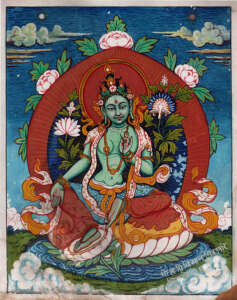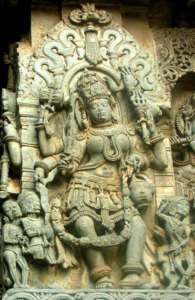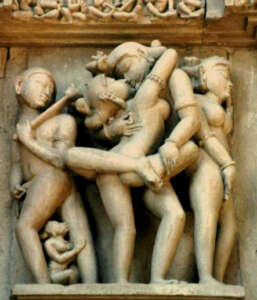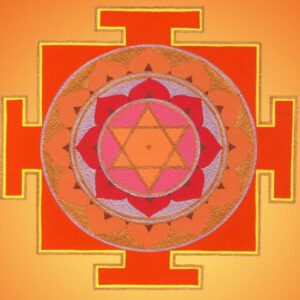Tantra is a holistic approach to the study of the universal from the perspective of the individual….
Tantra
Tantra

Green Tara in Buddhism
Tantra consists of the use of mantras, deities, rituals, visualizations, yantras and meditation to study the universal from the point of view of the individual. In this respect, Tantra is a more energetic and technique-based method for spiritual development.
Tantra as yoga recognizes that we are able to transcend our “programming” in order to connect with the cosmic energies of the universe.
Tantra as a tradition is an extension of the yogic and Vedantic teachings. Like the Vedic tradition, it honors the forces of nature as part of greater powers of cosmic intelligence, the devas or devatas, the great gods and goddesses of nature.

Mutter Natur
Tantra-Yoga
As tantra yoga, tantra uses all aspects of yoga from asana to samadhi. The question often arises as to whether tantra can be clearly distinguished from yoga, but this is impossible. There is, however, a clear distinction that provides an understanding of both sciences.
In Patanjali’s eight-fold yoga, the yogi aims to attain enlightenment through detachment from the material world. Patanjali gives instructions here to stop the breath, stop wrong behavior, stop movement of the body and stop thoughts and the mind itself.
In Tantra, instead of turning away from the energies of the material world, we use rituals and tools to recharge and transform this energy from the gross to the subtle. The path is the same, but the philosophies differ in the first approach.
This is why tantra yoga, which combines classic yogic tools such as pranayama, asana and pratyahara with tantric elements such as mantra or yantra, also rightly exists. Due to the openness and flexibility of both systems, it is therefore impossible to make a clear distinction.
Tantra and Sex

Tantra und Sex
There is a lot of talk in the West about the sexual form of Tantra. It certainly has its place when it comes to bringing healing, wholeness and transformation to human sexuality and therefore to our lives as a whole.
Sexual energy is perhaps our most powerful force for healing or disrupting the body and mind. It is also the root of all cosmic energies such as Shiva-Shakti or the cosmic masculine and feminine forces. But sexual tantra is only a small part of the larger field of tantra. In today’s society, we are fascinated by sex, which is why we consider this focus important in Tantra.
Tantra and Kundalini
The term Kundalini stands for the awakening of Shakti, the universal force that gives life and movement to the universe. In Swaha Yoga, this science is illuminated through practical techniques. Three main energy channels run along our spine from the tailbone up to the skull. These energy channels calibrate our system, give us consciousness and are the gateway to our energetic awareness, which remains hidden during our human existence.
Kundalini Yoga
Prana is the life force in all things. There are many different types of prana in our body alone, which are responsible for the automatic functioning of our body. The purest form of prana is Kundalini. Tantra Yoga is therefore Kundalini Yoga because we want to transform our body and our pranas from the gross to the subtle. In this respect, we can see that Kundalini is the highest energy available to us.
Malas to support concentration

Mala
Malas or rosaries are important tools of worship and healing. They relate to different deities and have their specific powers that can be used to hold the energies of mantras in different ways. Rudraksha is the most commonly used mala. It is the seed of a special tropical tree.
Concentration is energy
Concentration is the alignment of our consciousness to a point and therefore also the alignment of energy. The vibration of the object of meditation determines the transformation of energy. In yogic and tantric techniques, we train concentration for the correct execution and centering of energy. Concentration is universal. Things become real when we concentrate on them.
The use of yantras
Yantras are special geometric visualizations for aligning the mind with a specific structure. They are said to be the energy form of the deity or the energy form of the mantra. They are a good aid to concentration and help us to connect with the inner power of the deity. Most yantras use a six-pointed star, but there are also other, more complex yantras. The best known is the Sri Yantra or Sri Chakra, which consists of nine triangles. Generally, yantras also have lotus flowers or lotus blossoms on the edge.
Basic forms used in yantras

Gayatri Yantra
Triangles pointing upwards refer to Pitta and Agni and to the Shiva principle. In tantric healing we want to redirect the gross energies into the subtle through rituals, mantras and Kundalini energy which also moves from the bottom to the top of the back.
Downward triangles refer to Kapha and Soma as well as the Shakti principle and symbolize the moon. The square refers to the earth element. Crescent moon refers to the water element.
Circles often refer to the sun.
Mantras
auṃ/oṃ bhūr bhuvaḥ svaḥ
tát savitúr váreṇyaṃ
bhárgo devásya dhīmahi
dhíyo yó naḥ pracodáyāt
Gayatri Mantra
Mantras are the elementary tool in Tantra. When we talk about the connection to the subtle, divine or spiritual world, this happens through our subconscious. The way there is through the decision to draw our concentration and our senses towards them. A mantra works with vibration on a physical and psychic level.
Mantra Meditation
When we meditate on a mantra, the vibration can set our mind into a vibration that enables us to penetrate into deeper layers of ourselves. A mantra is therefore the ultimate tantric tool to transform our mind from gross thoughts to a subtle consciousness, far beyond our human conceptions.
The root chakra, also known as the Muladhara chakra or base chakra, is the first of the…